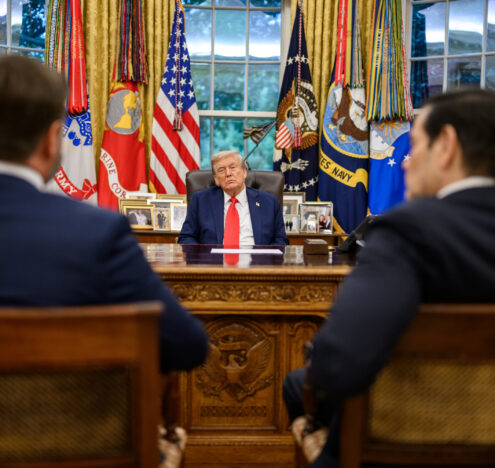In mid-December, Republican presidential candidate Vivek Ramaswamy used the primary debate stage as a platform to promote the Great Replacement conspiracy theory, which he claimed was not “some grand right-wing conspiracy theory, but a basic statement of the Democratic Party’s platform.” This dog whistle was certainly heard. A coalition of white supremacists and racists like Nick Fuentes subsequently celebrated the latest mainstream recognition of their cause and further amplified the hateful message online. Just last week, former Iowa congressman and white supremacist Steve King endorsed Ramaswamy’s campaign and praised his commitment to “pardon peaceful Jan. 6 protestors on day 1, and to end birthright citizenship for kids of illegals in this country.”
Even as antisemitic white replacement conspiracy theories like the Great Replacement have inspired nearly a dozen terrorist attacks, right-wing media personalities and elected officials have engaged in sustained and coordinated efforts to seed white replacement narratives into the mainstream American public consciousness.
In an election year already dominated by culture war tropes and fascist rhetoric accusing nonwhite immigrants of “poisoning the blood of our country,” the invocation of the antisemitic Great Replacement is likely to inspire racially motivated violence in 2024 and beyond.
Origins
In his 2011 essay “Le Grand Remplacement,” French author Renaud Camus first coined the term, which would become his magnum opus. When adopted by antisemites, versions of the Great Replacement trumpet the false claim that nonwhite minorities are deliberately replacing white Europeans through immigration facilitated by Jews (who are frequently identified in these conspiracies as “globalists” or “the global elite”) and would become one of the most prominent conspiracies within the transnational far-right movement, beginning with the Identitarian movement in France, particularly Generation Identity.
The now-banned far-right extremist group heavily promoted the Great Replacement on social media platforms like YouTube and Twitter, and by 2017, this antisemitic conspiracy found fertile ground in the resurgent American far-right milieu. Following the 2016 US presidential election, the Great Replacement had migrated to the United States, as echoes of Camus’ Replacement were heard throughout the streets of Charlottesville, as white supremacists chanting “Jews will not replace us!” attempted to bring the disorganized American right-wing landscape together at the deadly Unite the Right rally.
Years of nativist and antisemitic propaganda targeting immigrants, minorities, and Jews allowed American white supremacists to popularize replacement-style narratives with ease. Neo-Nazis long centered their grievances on the perceived threats to a pure, white America by minorities and Jews, exemplified by such slogans like David Lane’s “14 words.” These “white genocide” or “white replacement” conspiracies sought to tap into the long-simmering hatred felt towards immigrants and minorities by the average American racist in the 20th century.
“Blueprint” for Violence
As the Great Replacement — and the broader constellation of “white replacement” conspiracies — grew in popularity, so too did the number of white supremacist acts of mass violence it inspired. Among the initial and most prominent of these were the July 22, 2011, attacks in Norway, which killed 77. The perpetrator, Anders Breivik, embraced replacement-style conspiracies like Eurabia in his 1,500-page manifesto that he published online on the day of the attack. Crucially, Breivik’s manifesto provided an ideological and tactical blueprint for the next white supremacist mass shooter, which Brenton Tarrant followed in 2019.
Tarrant, who openly praised Breivik and titled his manifesto “The Great Replacement,” murdered 51 Muslim worshippers in Christchurch, New Zealand, in an attempt to “incite violence, retaliation and further divide between the European people and the invaders currently occupying European soil.”
Tarrant’s live-streamed mass murder would serve as a catalyst for deadly attacks in El Paso, Texas, in 2019 and Buffalo, New York, in 2022, in which the perpetrators glorified Tarrant and supported the Great Replacement Theory in their manifestos. In turn, those who successfully perpetrate mass racial violence are martyred and celebrated by far-right extremists online, creating a niche extremist community that incubates and inspires further mass indiscriminate violence against their nonwhite enemies.
White Replacement in 2024 and Beyond
These acts of mass violence make clear that the spread of antisemitic conspiracy theories like the Great Replacement across the darkest corners of the internet will one day inspire the next Breivik or Tarrant.
However, perhaps equally alarming is the degree to which replacement rhetoric has become accepted by an increasingly large subset of the population. In the birthplace of the Great Replacement, for example, an October 2021 poll found that 61% of the French public believed that a racial replacement of white, Christian Europeans would occur in France, while an October 2022 poll showed that one-third of Americans and two-thirds of Republicans “endorse some form of the tenets of the ‘Great Replacement’ Theory.”
Featuring not only the Great Replacement but deep state conspiracies involving the Sept. 11 attacks, the Jan. 6 Capitol riot, and both the 2016 and 2020 elections, Ramaswamy’s rant is emblematic of the volatile mix of conspiratorial narratives that define this fascist movement today. Furthermore, this web of conspiracies held together by antisemitic glue is the direct consequence of the reactionary right’s intentional weaponization of demographic changes through white victimhood narratives. As the ongoing “culture war” against the deep state globalists continues against the backdrop of natural demographic changes in America, traditional media, elected officials, and extremist Telegram channels will likely continue their efforts to intentionally inject white replacement conspiracies into the discourse.
Tucker Carlson, for example, amplified or explicitly mentioned the Great Replacement in more than 400 episodes of his Fox News show between 2016 and 2021. More recently, in November 2023, Elon Musk endorsed a post on X that claimed that Jewish populations in the West support “hordes of minorities … flooding their country” and has continued to promote and engage with replacement-aligned content on X in the early days of 2024.
As these influencers and media personalities continue to use social media platforms to spread antisemitic conspiracies, more “normies” are likely to become radicalized and embrace increasingly dangerous and violent ideologies. At the same time, each time elected officials promote white replacement conspiracies to millions of Americans, lone actors looking for justification to commit violence against out-groups in a broader culture war won’t need to understand the deeper ideological nuances of Camus to hear a call to arms to kill those who they have been taught to hate.




















